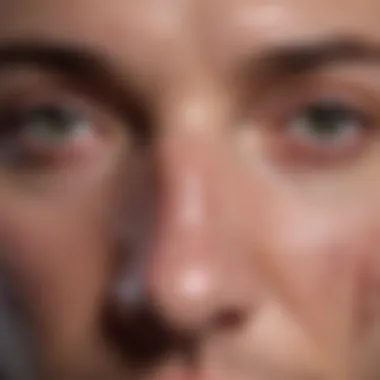Effective Strategies to Eliminate Broken Capillaries on Nose


Well-Being Overview
Intro
Broken capillaries on the nose are more than just a cosmetic concern. These small blood vessels, also known as spider veins, are often visible and can detract from one's physical appearance. Given that they can emerge from various factors such as extreme weather, genetics, or skin conditions, it’s crucial to understand both the underlying causes and effective removal strategies. In this guide, we explore a holistic approach that includes various remedies and professional treatments. This culminates in a pathway to reconstruct not only aesthetic value but also self-assuredness.
Recognizing the importance of targeting this aspect of wellness is essential. Many individuals hide their skin conditions due to insecurity or embarrassment. Conversely, addressing the issue promotes not only physical healing but mental empowerment through enhanced confidence. Hence, our focus here deepens understanding and shines a light on practical solutions.
Causes of Broken Capillaries
Identifying causes aids in prevention strategies. Common reasons include:
- Sun exposure
- Aging, leading to loss of skin elasticity
- Genetic predisposition
- Use of harsh skincare products
Navigating these influences equip individuals with knowledge to better care for their skin. Regular check-ups and maintaining skin health can mitigate the occurrence of broken capillaries.
Treatment Options
Home Remedies
There are several home-based solutions to diminish the visibility of broken capillaries. Coconut oil can help moisturize and strengthen the skin. Also, applying vitamin K cream is believed to reduce visibility over time. Hydration is one of the simplest methods and drinking an adequate amount of water keeps skin supple.
Professional Treatments
For those seeking quicker solutions, there are professional treatments available:
- Laser Therapy: A popular method where concentrated light targets and remedies visible vessels.
- Sclerotherapy: Mostly for larger veins, although it varies regarding broken capillaries.
- Intense Pulsed Light (IPL): A technique that produces light pulses to alleviate discoloration.
Epilogue
In summation, dealing with broken capillaries involves understanding their roots and available solutions. Through awareness and preventative measures, individuals can cultivate a lifestyle that fosters both skin health and self-perception. Removing broken capillaries not only serves visual appeal but implicates a broader narrative of individual confidence, empowerment, and well-being.
Understanding Broken Capillaries
Understanding broken capillaries is a crucial part of addressing this condition that many individuals experience on their nose and other facial areas. This section delves into the characteristics, causes, and implications associated with broken capillaries. Clarifying what they are helps comsumers understand their own health and skincare choices. Awareness enables informed decisions about interventions and specific treatments.
Definition of Broken Capillaries
Broken capillaries, or telangiectasia, occur when tiny blood vessels near the skin's surface become enlarged or damaged. This can result in a noticeable red, blue, or purple tint, often giving the skin an uneven appearance. It's a frequent concern for many, especially those who prioritize skincare. Identifying the problem early is essential, as it can prevent worsened conditions.
Causes of Broken Capillaries
Understanding the root causes that lead to broken capillaries is pivotal for effective management. Identifying triggers involves exploring genetic, environmental, and skin-related factors that contribute to vulnerability.
Genetic Factors
Genetic factors play a significant role in the development of broken capillaries. Individuals with a family history of varicose veins or delicate skin may be at a higher risk. The predisposition to weakened capillary walls is often inherited. This genetic inclination makes it critical to recognize the signs early, particularly for those who observe it in family members.
Environmental Influences
Environmental factors such as extreme weather, sun exposure, and pollution can lead to increased chances of broken capillaries. Harsh climates can irritate the skin, resulting in broken blood vessels. UV rays can also damage the skin's structure, highlighting the importance of sun protection. Maintaining a balanced environmental approach to skincare is necessary for prevention.
Skin Type and Sensitivity
Skin type and sensitivity significantly contribute to the likelihood of broken capillaries. Individuals with thinner, more sensitive skin are more susceptible. Conditions like rosacea may compound this issue. Experimenting with strong or irritating products can exacerbate existing conditions and initiate new problems. Understanding one's skin type is essential in developing effective skincareregimens that avoid further damage.


Symptoms Associated with Broken Capillaries
Recognizing the symptoms of broken capillaries can lead to timelier prevention and treatment efforts. An overview of the visual aspects and any discomfort associated is essential here.
Visual Indicators
The visual indicators of broken capillaries are typically easy to identify. These often present as fine red or purple lines readily apparent on the nose area and cheeks. Recognizing these signs often leads to faster intervention, which can prevent more significant concerns down the line. If untreated, these veins could create further aesthetic issues, impacting an individual's confidence.
Potential Discomfort
While broken capillaries may primarily be a cosmetic issue, some individuals report discomfort, itching, or a burning sensation in affected areas. This discomfort often urges people to seek treatment. The combination of visual indications and discomfort can create significant challenges for emotional and physical well-being.
Understanding these elements gives a solid foundation for pursuing effective solutions, whether they involve home remedies or professional treatments.
Home Remedies for Broken Capillaries
Home remedies play a crucial role for those seeking to address broken capillaries on the nose. These approaches often provide a gentler, more natural alternative to invasive treatments. Individuals may turn to remedies at home due to their accessibility and affordability. Exploring these options can empower readers to find solutions that fit their lifestyle.
Topical Treatments
Natural Oils
Natural oils present a popular choice for those looking to combat broken capillaries. Oils like jojoba and almond provide essential fatty acids that can support skin health. Their moisturizing properties soothe irritation and could lessen the appearance of these capillaries. This makes them a beneficial option, especially for individuals who prefer holistic solutions. However, some natural oils can cause allergic reactions. Testing a small skin area is advised before broader application.
Aloe Vera
Aloe vera stands out as one of the most beneficial remedies. It holds notable soothing properties and is famous for its anti-inflammatory effects. This plant is widely regarded for improving overall skin condition, making it suitable for individuals with broken capillaries. Its gel-like texture is a refreshing addition when applied directly onto the skin. Additionally, aloe has hydrating qualities. However, if used in excessive amounts, there can be instances of skin irritation.
Vitamin K Cream
Vitamin K cream is recognized for its properties in reinforcing capillary walls. Many like to consider it a go-to solution for discoloration issues associated with broken capillaries. The key benefit of Vitamin K is its natural ability to promote proper circulation and blood flow. Patients often appreciate its history of use in skincare. On the downside, it may require consistent application over time for meaningful results, with noticeable improvements not always immediately evident.
Dietary Considerations
Diet significantly affects skin health, including broken capillaries. Nutrunque consumption can enhance the body’s capacity to support and heal skin. Understanding dietary choices can expand options when managing skin issues.
Nutrient-Rich Foods
Introducing nutrient-rich foods into one's diet is pivotal. Foods abundant in vitamins C and E - such as citrus fruits and nuts - actively contribute to skin repair. Additionally, antioxidants found in berries can stave off oxidative stress damaging capillaries, thus fostering skin wellness. This plan serves as an effective method for individuals not ready for intensive treatment but seeking preventive measures. A potential downside lies in the accessibility of fresh ingredients for some, especially in off-seasons.
Hydration Importance
Maintaining proper hydration is vital for skin health and, consequently, for managing broken capillaries. Drinking sufficient water daily improves skin elasticity and complexion. In addition, hydration encourages optimal circulation and can detoxify the body. However, it may require diligence and discipline since people often overlook their liquid intake. Suggested guidelines generally recommend drinking at least 8 glasses, or 2 liters, of water per day.
Lifestyle Modifications
Adaptations in daily life can provide notable advancements in managing broken capillaries. Simple changes can create powerful results.
Sun Protection Measures
Taking proper sun protection measures can dramatically decrease the instance of broken capillaries. SPF, limits of sun exposure, and protective clothing are wise strategies. The key characteristic of these measures is prevention. Consistent engagement with sunscreen protects the skin from damage that could exacerbate weak capillaries. Despite its many benefits, some people may ignore daily application due to forgetfulness or negligence.
Avoiding Extreme Temperatures
Extreme temperatures can stress the skin and lead to more noticeable capillaries. It is practical for individual. Taking precautions can involve avoiding hot showers and stepping out in frigid weather without proper protection. This technicality deserves appreciation. However, practicality in controlling surrounding environments remains complex and often unavoidable. Minor adjustments to one’s habits can benefit the overall condition of their skin significantly.
Prioritizing comprehensive self-care holds the key to managing visible broken capillaries effectively.


Professional Treatments for Broken Capillaries
Professional treatments offer significant advantages when it comes to addressing broken capillaries on the nose. These methods can provide more immediate and effective results compared to home remedies. Understanding the specific treatments available is essential so that individuals can choose the best approach according to their condition.
Laser Therapy
Types of Laser Treatments
Laser therapy is a common choice for treating broken capillaries, utilizing concentrated beams of light to destroy the damaged vessels. Continuous wave lasers like the Nd:YAG, along with pulsed dye lasers, are popular options due to their effectiveness.
This approach allows for targeted treatment with minimal impact on surrounding skin surfaces. Since the procedure is quick, many patients prefer laser treatments because of efficiency. However, potential discomfort is something to consider too. Consultation with a skilled practitioner is crucial for optimal outcomes.
Expected Results
The expected results from laser therapy can be significant. After undergoing this treatment, many individuals notice reduced redness and fewer visible capillaries. The improvement might be observable almost immediately post-treatment.
It's important to note that while results vary by individual, most can anticipate clearer skin as a common outcome. Regular follow-ups may be necessary to maintain clear skin, as some individuals might experience a need for periodic treatment.
Sclerotherapy
Procedure Overview
Sclerotherapy involves injecting a solution that irritates the lining of blood vessels, closing them off and thus eliminating the visual aspect of broken capillaries. This effective strategy allows for multiple capillaries to be treated in one session.
It's regarded as a reliable method for people with prominent spider veins. However, swelling or bruising at the injection site can lead to some temporary discomfort, which typically resolves quickly.
Success Rates and Considerations
The success rates of sclerotherapy are generally high. Patients often report considerable long-term improvements in skin appearance following treatment. However, personal health history can affect outcomes, and some may need several sessions for full effect.
Possible side effects might occur too, so it is necessary to understand the risks involved. Consulting with healthcare providers help patients weigh the benefits against the potential downsides of this treatment.
Intense Pulsed Light (IPL) Therapy
Treatment Mechanism
Intense pulsed light therapy employs flashes of broad-spectrum light to target blood vessels just beneath the skin. The energy from the light causes hemoglobin in the capillaries to absorb heat, leading to their destruction.
IPL is often chosen for its suitability across skin types, making it a good fit for a diverse demographic. Moreover, the treatment's non-invasive nature makes it approachable for those who are hesitant about surgical procedures. However, recovery time can vary among individuals.
Post-Treatment Care
Post-treatment care is a crucial aspect after undergoing IPL therapy. Applicable follow-up guidelines typically include avoiding sun exposure for a period, using gentle skincare products, and integrating soothing creams into routines.
While some advocate for makeup use to cover any redness, it is advisable to allow the skin to breathe shortly after treatment. Paying attention to skin reactions helps in achieving the best long-term outcomes. Regular moisturizing care can promote healing while maintaining improved skin appearance.
By using professional treatments, individuals can effectively combat the issue of broken capillaries, leading to improved confidence and skin health.
Preventing Broken Capillaries
Preventing broken capillaries is a crucial topic when discussing their management, especially when it involves visible areas like the nose. Awareness of potential triggers and incorporating proactive measures can significantly mitigate occurrences. Understanding how to avert this condition not only enhances physical appearance but also contributes to a person's overall skin health.
Identifying Triggers
Broken capillaries may emerge from various sources of strain or irritation. Recognizing these triggers is a first step in prevention.
Stress Management


Stress is a key contributing factor to broken capillaries. High levels of stress can lead to increased blood pressure, causing blood vessels to swell which, over time, may result in them breaking. A notable characteristic of effective stress management includes adopting practices like deep breathing and time management. These approaches contribute positively to skin health since they are beneficial strategies.
Some unique aspects of incorporating stress management techniques in a skincare routine include their long-term scalability and low-impact nature. For many, consistent implementations of these techniques lead to improvements in skin resilience. However, some may struggle to prioritize these methods amid busy lives, pointing to a challenge.
Skin Care Routines
Routines tailored to individual skin types play a significant role in preventing broken capillaries. Individuals must recognize their skin's sensitivity and adjust their regimen accordingly. A notable feature of effective skincare routines is the careful selection of gentle products that are free from irritants. This becomes essential in maintaining skin integrity.
Since adopting a consistent skincare routine serves to shield the skin from trauma, the advantages include enhanced resilience and a smoother texture. On the flip side, rigid routines may sometimes complicate an individual's ability to adapt when introducing new products or treatments.
Health and Wellness Practices
Maintaining general well-being is foundational in minimizing broken capillaries. Factors including physical activity and emotional well-being attract attention in this context.
Regular Exercise
Regular exercise serves as a natural regulator for heightened blood circulation. Coupling it with practical stress-relief mechanisms can prevent health issues, including broken capillaries. A defining feature of physical activity is its capacity to enhance overall cardiovascular health. This feature is crucial when aiming to guard against potential skin damage.
Furthermore, categorized as a beneficial approach, exercise builds physical endurance. It fosters resilience not just on the skin, but throughout the body. Nonetheless, unrealistic exercise expectations may pave the way for potential tension, resulting in adverse outcomes instead of expected benefits.
Mindfulness and Relaxation Techniques
Mindfulness and relaxation techniques are essential for sustained skin health through their stress-reduction capacity. Practicing mindfulness—a strong component—to manage emotional states demonstrates a direct impact on self-regulation.
These techniques present unique features, as they foster a regular practice conducive to sustained mental clarity and focus on living in the moment. Regular application can lead to marked improvements in emotional health, critically impacting physical appearance, especially in stress-laden individuals. As a downside, some may regard these methods as challenging due to the time required for proper execution in daily commitments.
Maintaining a balanced lifestyle translates to a protective barrier against broken capillaries.
In sum, addressing potential triggers remains pivotal in preventing broken capillaries. Awareness, intention, and a commitment to adaptive lifestyle practices not only assist individuals in making preventive measures but also enhance wider health objectives.
When to Seek Professional Help
Recognizing when to seek professional help for broken capillaries on the nose is essential for effective treatment. While some cases may respond well to home remedies and lifestyle changes, others require the expertise of a healthcare provider. Professional help ensures that appropriate methods are utilized based on the severity and underlying causes. Addressing this concern early can prevent further complications and improve treatment outcomes.
Signs of Worsening Condition
It is important to monitor the condition of any broken capillaries. Not just for aesthetic reasons, but for those that can indicate health issues. Here are key signs that may suggest the situation is worsening:
- Increased redness: If the capillaries become more pronounced or red over time, it may require professional assessment.
- Pain or discomfort: Any accompanying pain that intensifies or becomes regular should prompt a visit to a dermatological expert.
- Swelling around the area: This can be a sign of inflammation which might need medical intervention.
- Changes in skin texture: If the skin around the capillary areas becomes rough or displays unusual changes.
Be attentive to these changes, as they may affect overall skin health.
Consultation and Diagnosis
Consulting a professional is crucial when dealing with broken capillaries. A healthcare provider will conduct a thorough examination. Here is what typically happens during a consultation:
- Detailed medical history review: Understanding your predisposition to broken capillaries is fundamental. This includes family history and any existing health conditions that may affect skin integrity.
- Physical examination: The practitioner will examine your skin type, assess condition severity, and consider associated symptoms.
- Possible diagnostic tests: Sometimes tests are necessary, especially if underlying health issues are suspected. Providers can assess hormonal balances or vascular health.
Following this, they will present treatment options tailored to your individual circumstances.
By seeking professional advice early, you can identify the best steps for treatment and possibly prevent future occurrences of broken capillaries.
Summary of Key Points
- Definition and Significance: Broken capillaries are dilated blood vessels visible under the skin, often seen on the nose and other areas, affecting aesthetic appeal.
- Causes: Factors such as genetics, environmental stressors, skin sensitivity, and lifestyle choices contribute to their occurrence.
- Symptoms: Visual signs include red or purple lines on the skin, which may accompany feelings of discomfort or sensitivity.
- Home Remedies: Options such as natural oils, aloe vera, and vitamin K creams can offer beneficial results. A balanced diet and hydration are vital for maintaining skin health.
- Professional Treatments: Strategies like laser therapy, sclerotherapy, and intense pulsed light therapy can provide significant and quick results but come with considerations around costs and recovery.
- Preventative Approaches: Identifying triggers and engaging in health and wellness practices, including mindfulness, can potentially mitigate the risk of developing broken capillaries.
Final Recommendations
When it comes to treating broken capillaries, it is essential to consider several factors:
- Assess Personal Skin Type: Recognizing whether you have sensitive skin may inform which remedies and treatments will work best to avoid irreparable damage.
- Choose Treatments Wisely: Individuals should weigh the pros and cons of both home and clinical options. Consult with dermatologists for tailored recommendations.
- Implement Preventive Strategies: Daily sun protection, hydration, and avoiding extremes in climate are easy but often overlooked steps for overall skin health.
- Monitor Changes: Keep track of any worsening symptoms or new developments. Early consultation with a healthcare provider makes a difference in managing conditions effectively.
By applying both professional knowledge and practical steps, managing broken capillaries can lead to improved skincare routines and enhanced self-confidence for individuals.



